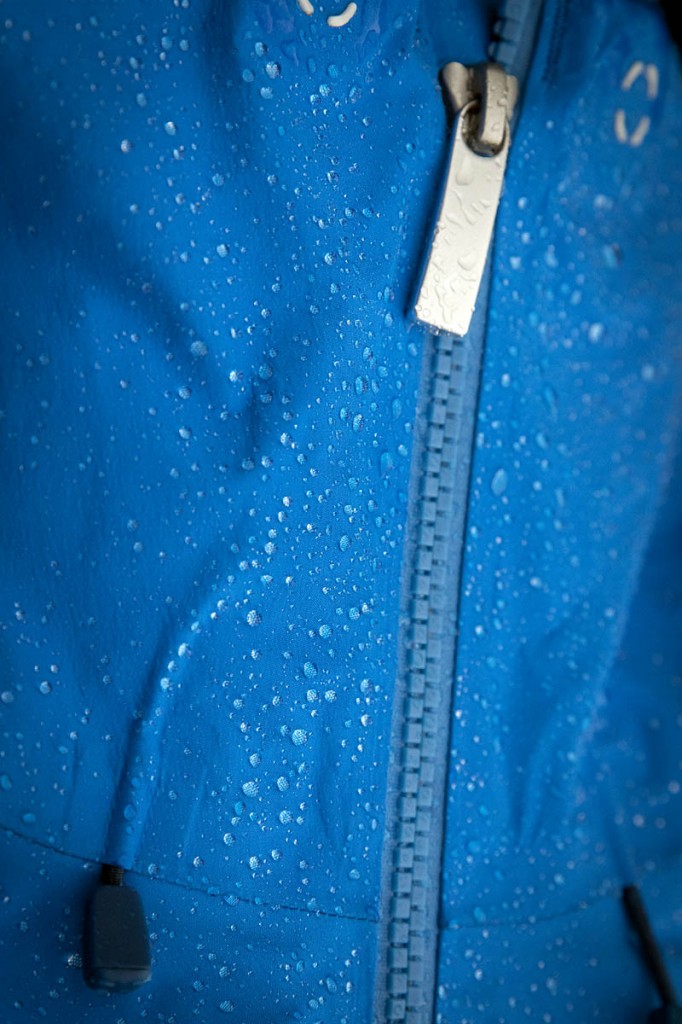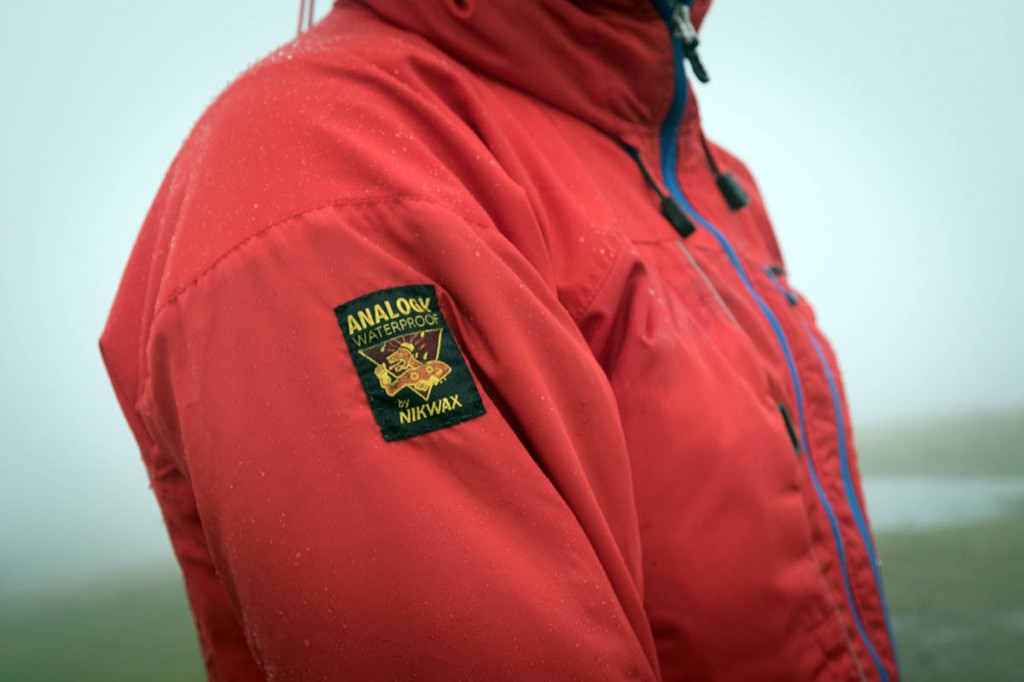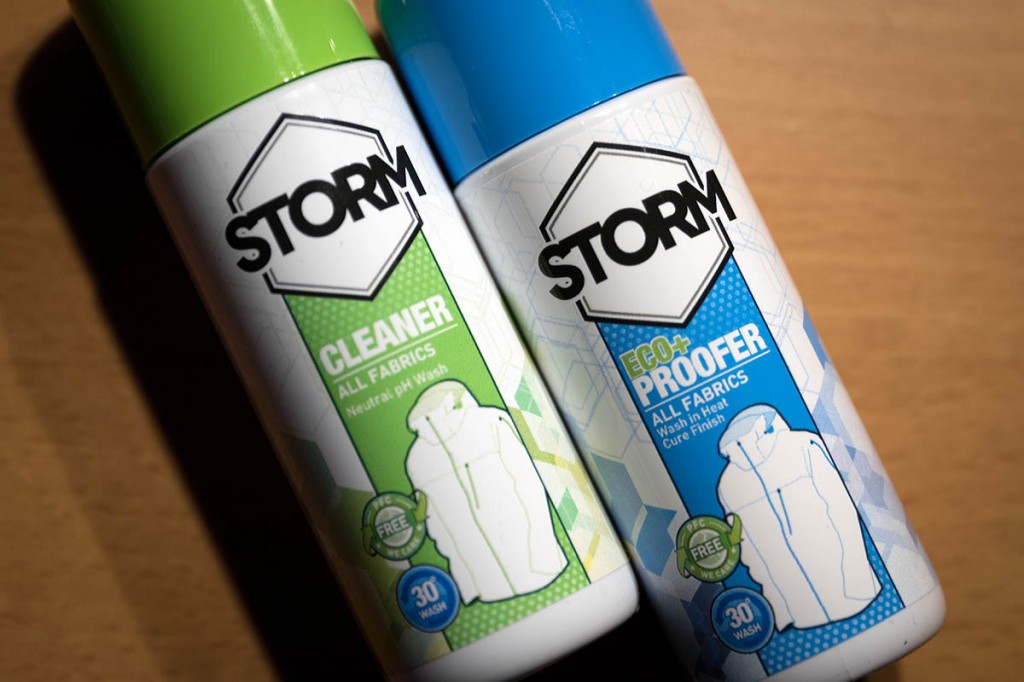Campaign group Greenpeace recently turned its sights on the outdoor industry for its use of controversial chemicals used in many of the outdoor clothing brands we use.
Here, industry expert Charles Ross gives his view on the matter and where the outdoor world goes from here.
One of the hot topics within the outdoor industry currently is PFCs. Perfluorinated compounds are used in the durable water resistant finishes on outer garments, or in plain speak they are the part of the DWR that gives that ‘tefal’ effect that makes the water bead up and run off your jackets.
The ‘wetting out’ of the DWR is what starts to cut down on the effectiveness of the breathability of garments.
Five years ago Greenpeace launched their Detox campaign with clever emotional marketing to retail and brands on the back of their Clean Clothes Campaign which highlighted the terrible state of pollution in the waterways of China as a result of the textile industry moving there towards the end of the last century.
I have yet to find a single member of the outdoor industry who disagrees with the desire of the campaign, but know lots who have problems co-operating with it. The main reason – something that might sound surprising in this age of white-coated scientists – is that all the replacement ingredients to PFC chemistry do not work as well as long chain fluorocarbon PFCs.
If there had been support provided by the NGO which enabled DWRs to continue to perform, but with better chemicals, then I am sure the industry would have adopted it. The campaign was targeted at the industry as this was the link that we outdoor enthusiasts could easily influence.
Previous efforts to lobby the chemicals industry by the campaigning organisation had been brushed off, but the tactics were seen most effectively when Zara, Europe’s biggest clothing retailer, was targeted in the run up to Christmas in 2012. In nine days the Spanish parent company went from refusing to host a conversation to signing on the dotted line.
The new accelerant came in the form of a Norwegian law that came into effect last year – textiles have a further two years to comply as their long supply chains lobbied for exceptions – banning the PFC chemicals. Although Norway is outside the EU, the European Commission takes note of what it does and why it did it. The fear was that the remainder of the Scandinavian Outdoor Group would adopt the same standard and Germany would get on board too as the most eco-nation in Europe.
Any change like this would make it near impossible for any brand selling across the EU to stock control – so the option would be to change all DWRs in Europe. When the brands got to grips with this they realised that DWRs all over the world would have to change: a magnificent case of 5 million people changing the whole 7 billion in the world for the better.
In recent years several substances of high concern have been put on a ‘blacklist’ and turned into European Law (Try Googling ReaCh).
The backdated restricted lists are being made law using a fast-track process. Although this will happen to the ‘bad’ chemicals in DWRs, experience demonstrates that new legislation could take up to a decade to come into effect as the 28 EU countries need to be in agreement, so the stop-gap PFCs are likely to be around for a while.
PFCs are something that are now in the environment and they will not disappear. Finally years of research have proved that long chain fluorocarbons are toxic: a bio-accumulative – ie they seemingly silently build up to a dangerous level in your body – and do not break down in the environment – ie the threat stays around and just gets worse.
The evidence has proved itself after years of studies. Even 3M has been caught out (Google Scotchgard withdrawal in 2000). The voluntary move by the textile industry has been to go from long-chain (C8 and above) DWRs to shorter-chained versions – evidence does not yet exist on C6.
The immediate result is that the DWR appears to not be as good as the long-chained version as it rubs off easier; but the intelligent thinkers are finding it hard to reason that the evidence against C8 will not apply to shorter-chained versions. C8 has been shown to travel 5,000 miles in three weeks and it has entered to food chain, and now progressed through it – effects are being seen in humans now. This stated the garment finishes that are currently used will not kill anyone in their dilute concentration.
Also worth considering is that the more coating you put on a fibre the less breathable the garment is. DWRs feature the benefit of acceptable levels of breathability – certainly more than the membrane can handle – while adding to the water repellency of the fabric.
Hence lots of confusion around the whole DWR subject. DWRs do three things: repel water, resist stains, and stay on the garment. DWRs themselves are only one part of the four factors that influence the breathability of a garment, but they are the biggest effect that can be compromised or enhanced with informed action.
For those that need a reminder of the detail mentioned earlier in this paragraph: breathability (for the majority of those in the outdoors nowadays never had a non-breathable PU Peter Storm as their first waterproof) varies because of four different factors: the outside humidity (there is a big argument that as we are a nation with almost no point more than 100 miles from the sea that this country is too humid for membranes like Gore-Tex to breathe as efficiently as when it is well inland like on the Alps); the amount of perspiration a body produces (depends on how much we sweat and how hydrated we are and how much insulation we are wearing); membrane (in simple terms the more breathable it is, the less waterproof it is and vice versa); plus the DWR (cheap ones wet out after minutes, the better ones can last for almost a quarter of the day in solid rain).
As there is little that can be done to the first three factors, most of the attention is being paid to the DWR. The other thing is that a DWR is just that – durable, but not permanent. It wears off – brushing against itself underneath your arms, against your pack straps, and against vegetation you squeeze past – plus can get compromised from the detritus of sweat.
Your body sweats to cool down faster and the side effect is the flushing out of all the dead cells in your skin – the stuff that causes BO. The latest version of the Arc’teryx Alpha SV features a double collar as the brand has recognised that detritus on the inside of a shell fabric will compromise the DWR on the outside of that fabric, thus the design solution is physically putting more material to block the way in the most affected area.
The replacement chemicals in the DWRs repel water well, are getting all the more durable as newer versions are produced (currently the most durable PFC-free DWR in the field is offered by a Japanese company, Amaterrace. Problem is that they are a fabric converter so their brand name is never seen); but on the third benefit – all the PFC-free versions are terrible at stain resistance.
This last category ranges from external effects such as grass stains, mud, food, to internal ones – the aforementioned skin detritus. As the problem has come to light, more attention has been paid to this area by bigger concerns. Long-chain fluorocarbons cover car seats and used to be used in food packaging (it was what stopped your pizza from sticking to the take-away box!), thus further research is being centred in this area.
The main line of thinking has progressed too. When Gore-Tex first created the breathable category most of the garment owners were too afraid to wash their jackets. Since the breathable fabrics have entered the higher aerobic activities of bike and run, they have been washed more often. Washing gets rid of the detritus.
However before you chuck your expensive garments in the machine, there is more to prepare. The physical side of the garment: do up zips and flaps, relax the drawcords, take out the stowed hoods, apply Velcro closures, and so on.
Next is to clean your washing machine. For those that speak old money this is called a service wash. Run your machine at its highest temperature option with no contents. Use ½ cup of white wine vinegar in the detergent drawer, having taken the drawer out of the machine first to clean it – chip off or wipe away the residue of dried soap powder.
A sign that your machine is operating inefficiently is that there is a build-up of detergent gunk around the rubber seal of the machine door. The manufacturers recommend (and you would know if you had read the thick instruction book that came with the appliance) that a service wash should be done every 20- 30 washes as it will make the machine wash better at low temperatures, as well as extending the operating life of the machine.
Always do a service wash before re-applying DWRs as DWRs are compromised by detergents: you need all trace of detergents removed from the machine to get the best from laundering and reproofing process.
Detergents are both bio and non-biological washing solutions. As a general rule they leave an anhydrous layer on garments: in common speak that means that they leave a water-attracting finish on the surface of your garment – the last thing you want for a water repellent finish!
The science of why detergents have taken over from pure soap concerns the water-loving finish which aids the flushing out of the soap solution (which by this stage has acted like a magnet to attract the dirts off the garment, prompted by the agitation of the machine motion).
Prior to detergents machines had twin-tubs: the washing was done in one tub, the rinsing and flushing out of the soap solution in the other one. Twin-tubs also required to flushes to get rid of the soap. Knowing this it becomes apparent how effective detergents are at attracting the water to get the soap flushed away.
As a general rule always wash the garment in a soap solution first (Dreft or Lux are commercial brands, Nikwax’s Techwash and Storm’s Cleaner are the specialist ones). Quite often just removing the soil and detritus will allow the fabric to perform back at its original levels of breathability; but every so often (for me it is twice a year) I need to reproof them.
If the garments have stubborn stains then you can use laundry additives (like Vanish or Shout) to clean them in a detergent wash – choose to rinse them a second time as well; then wash them in pure soap too, remembering to rinse them again to ensure a good flush out of the cleaning solution; next re-proof them if required; finally heat seal them.
Whatever solutions you use it is important to ‘cure’ them afterwards. Some re-proofing solutions offer the ability to air cure, but a heat cure will always be much more durable. People have been afraid to put their garments underneath a cool iron or low tumble dry – but the nylons & polyesters used as face fabrics, have been engineered to cope with this. Even if you miss out the re-proofing stage, still heat finish the garments for best performance.
In the future it is hoped that a better DWR will be developed. Who knows it might even become a PWR. There has been some world-leading research done in Yorkshire in using ‘plasma’ technology to apply the DWR – initial results show better results in both durability and stain resistance; plus last year the Patagonia-backed investment fund ‘$20 Million & Change’ put over $1m into a Swiss green chemistry company best known for stain-resistant technology.
Beyond Surface Technologies might well share what they develop – like Patagonia did when they pioneered Synchilla fleece.
In the short term people need to be aware that the performance of DWRs on garments will change for the worse, compared to how the finish works now, but if the garments are looked after properly they will perform to current standards and longer than a C8 unloved garment. In a world where people are prepared to get a car regularly serviced, is it too much for them to apply the same thinking to their outdoor shells?
Charles Ross is a lecturer in performance sportswear design at Falmouth University. He has taught many of the Millennials who now lead the design of the outdoor industry. His graduates are in Mountain Equipment, Rab, Arc’teryx, Berghaus, Patagonia, Páramo and Montane among others.






Chris jones
13 April 2016Excellent article this has answered questions I have had myself for years
Malcolm Bruce
13 April 2016What does DWR stand for?
You don't actually say in this article!
charles ross
14 April 2016Malcolm
The second sentence
>Perfluorinated compounds are used in the durable water resistant finishes on outer garments
<
rgds
OurtdoorsAndy
14 April 2016No mention of Tx Direct, the Nikwax PFC free DWR? I have used it for years and find it very good.
As for jackets, with most things you get what you pay for.
However, why Paramo remains the only company with a liquid water moment system is a little strange. I guess its to do with us been such a small market with such specific requirements, (cold wet and above all humid). I have yet to find a better water-proof solution than that offered by Parmo for use in the UK. (NB for low level summer use I use windproof and just get wet in the worst rain).
Thought anyone??
Richard Hamshire
14 April 2016At McNair Shirts we about to launch the first batch of shirts that uses the Plasma treatment from Yorkshire. The results vary depending upon the fabric but we have had good results. The first product will be online in about two weeks.
charles ross
14 April 2016Andy
The article mentions Nikwax products, however it is not a comparison on re-proofing products - rather one on the debate around PFCs (plus the product care when you maintain the DWR)
Tx Direct is good, but made more durable if you heat seal the finish - as opposed to air dry; however it is not the only PFC-free re-proofing treatment
Paramo products are windproof & highly water resistant. They fail waterproof tests. Their range is sold both in this country & central Europe with success
http://www.paramo-clothing.com/de-de/
Certainly if you are out just for the day & always producing body heat it is nearly impossible to get water to come through the shell & onto your body - but 'nearly' does not pass the tests...
rgds
Dave legh-hayton
15 April 2016having bought tons of paramo over the years I have now reverted to membrane waterproofs, my carbon footprint has probably decreased substantially by not constantly trying to reproof the mountain of paramo stuff I have to no avail......yep all done by the book...machine wash , hand wash, hopeless...disappointing
OutdoorsAndy
16 April 2016Hi Dave, sounds like you might of had a faulty one?
I have a 14 year old Paramo Aspira Jacket, which has been through some terrible weather in Scotland and coped with it as well as anything I have ever owned. I have washed it hundreds of times and it still works the same as the day I bought it. I have no other hard-shells that have lasted under the same use. I have many other Paramo garments and so does my wife, all of which give good service. A friend bought one and it leaked out of the box and they replaced it and it worked well.
I had a top of the range Berghaus Extrem Gore pro-shell and I sold it after the first serious ware, sweaty and noisy, (especially with the hood up), compared with my Paramo.
For me its about moisture management and nothing compares to Paramo in this country, in my experience.
Hi Charles. Its a long article and I read it as oppose to studied it. I thought the closing paragraphs and conclusion was also to look at alternatives to the present PFC's as a DWR and you talked about the future of DWR's. But there seems to be one on the UK market that is PFC free, claimed to be environmentally friendly, made in the UK by a UK company and in my experience works very well. Your thoughts on that would have been great as with the other's you mention.
Its a good article and speaking to other hill users DWR's are often little understood and this article helps peal back some layers of knowledge behind wash and re-proof. The re-proof section is great.
The heat sealing thing for TxDirect is interesting. I once spoke to a Nikwax rep and he said that heat did not affect the end water repellency and was unnecessary. It would be great to hear their comments on this and the general debate. He also explained that Nikwax was not more widely used by companies as it needed to be washed in by the manufacturer and this was cost prohibitive. (I did my own tests on a jacket many years ago, the grangers PFC coating only seemed to work after heat and the Tx Direct did not seem immediately affected by heat. This was a basic test however). I seem to remember the rep saying it did not affect breathability of hard shells either, due to the way it bonded to the fibre, but my memory could be wrong with this. The other thing is that they suggest that you only re-proof occasionally, while washing often, (to remove the build-ups you mention), and avoiding the need to use the more costly re-proofing chemicals. In addition to this, he claimed that Tech-wash contained a chemical that had the ability to neutralise an amount of the Detergent so that as long as the machine was powder free and clean you should be OK not to pre-clean the machine especially for the wash, (i will try emailing them to see if they will make some comments here).
At the same show I spoke to a Paramo rep and while Paramo is not water-proof in the outdoor industry sense, (in that a column water test will not work on the system, or more accurately, it will fail to pass the rather poor British Standard to be called water-proof), it is water-proof in terms of hill use in a practical sense, (when compared to other water-proof garments). I'm sure he said it was the only garment to pass the Leeds Uni rain room test and Trail, (as far as you might trust them), often comment on its water-proof properties. In a sense, as my understanding of it goes, there is no breathable fabric that is truly water-proof, it is all grades of water-resistance. So it would seem the test you refer too is perhaps flawed for real-world usage.
The fact that Mountain Rescue use it must say something about Paramo's utility in the UK.
charles ross
18 April 2016Andy
MRTs also use other systems than Paramo; that clothing is designed in this country - but not made here. Nikwax is a re-proofing solution; the objective of this article was to discuss the DWR finish on the majority of the fabric that the garments are made from, not the re-proofing
If, as you say, that Nikwax is not being used by other brands then (in the overall) picture - it is not going to be a popular option to consider. However it might be different when you consider Nikwax as a re-proofer
I agree with what you & the Leeds Uni Performance Clothing team are saying, but whilst there is a British standard - that is how things are measured
Techwash does neutralise some of the detergent effect, but if you want to get the solution to work to its best - then clean the machine first. In the current situation where the vast majority of machines are not cleaned, it is wise to (it will also the lower the overall carbon footprint as the machine will now wash more effectively at lower temperatures) - just to extend the life of the machine
You are right in that Tx Direct can be air-dried - whether it is or not does not affect the water repellency, but it DOES effect the durability. The Grangers re-proofing solution must be heat-finished (the nature of re-proofing involving PFC treatments)
Personally I am not a fan of Grangers - mainly as that company still uses PFC treatments; but both Storm & Nikwax deserve the praise they get. Storm use a German originated system, but if I was to use that brand name, it would be pointless as it does not supply to consumers
You are right that I have not been as accurate as I could have been in that within the majority of fabrics (especially when you stretch it out to schoolwear & car upholstery) there is the occasional one that is PFC-free, but this is still a minute percentage of the market. The market believes that stain resistancy is important
This article tried to concentrate on the hassles being faced by the vast majority of outdoor waterproof clothing owners with the changing legislation of fluorocarbons. The second half was about how to treat the laundering process to get the best out of your garment. I was not trying to go into detail about the re-proofing process - that is a separate subject
rgds
OutdoorsAndy
27 April 2016Hi Charles,
I didn't say Paramo made their clothing here, but that Nikwax made their DWR here, (the story of the majority of Paramo's manufacture is interesting and if true is an example to the cloths industry to follow, which sadly seem so often to prize economic slavery and child labour).
You are of course correct in saying that Mountain Rescue use other clothing, but as a water-proof I see then using little else and have friends in teams that swear by it. As I have already mentioned, it would be great to see a similar system from another manufacturer. (As for producing body heat, I only thought you stopped doing that when you died)?
I thought that the article started discussing the problems facing the clothing industry and the need move away from PFC's, (we seem intent as a species to continue to run chemical experiments on the biosphere in the hope it won't turn out badly for it and therefore us).
The point I was trying to make was that for the consumer, (and perhaps the clothing industry), there was already a locally made and distributed outdoor clothing DWR system that worked and was an adequate replacement for PFC products with seemingly none of the environmentally damaging effects, (and given the german one you spoke of is not a consumer available product that list would seem very small). Again, your views on TX direct would be interesting, (especially given it has allegedly been reformulated recently to make it more durable suggesting that Nikwax is continuing to develop its products). Do you have a reference for TX Direct needing heat sealing to increase its ware-life- I would be interested to read that?
That the outdoor clothing water-proof rating is not fit for purpose doesn't help anyone, least of all the consumer. The HH level for something to be called water-proof in the UK is a joke and has lead to many poor products entering the market place and then the hills, (and a land fill site soon after). It is a shame that the major cloths manufacturers have not been able to find an easy to understand, (for the consumer), real world rating system for both water-proof and breathability in outdoor garments. Perhaps one for the education industries to innovate and help us move away from the "not fit for purpose" one we have now?
It would seem, and perhaps wrongly, that in the present market place, the consumer just needs to switch to Nikwax and use your above advice in-reproofing, (it would seem the true problem facing consumers is a lack of knowledge of aftercare, which in my limited experience is very much the case). Given its distribution that should not be hard.
It would be great to see after-care information that is easy to follow on swing tags. Some do this, but most are lacking.
I really do hope for a new "earth friendly" DWR, to run along side or even replace TX direct, as innovation and competition in industry can be a good thing. But we should stop treating the earth as a toilet as of yet we only have this one to live in.
rgds
charles ross
18 May 2016Andy
The article was aimed at the majority; it is a minority than use Paramo
Paramo is more than just Nikwax; you need to look at the combination of the design of the fibres
The body heat effect when you take the garment off to camp at night disappears. Body heat helps accelerate the transfer of moisture. If you have a Ventile or waxed cotton jacket you will know what I mean
Too many people go straight to re-proofing, whereas the tests I have seen point towards cleaning should be done for up to six times, before a re-proof is required. Most of the contamination comes from dirt on the outside & skin detritus on the inside (the body oil wash out on the inside of the membrane will still compromise the DWR on the outside of the fabric)
With Nikwax I get my information from either Nick Brown (who started the company) or Shailja (the chief chemist)
The German chemical solution is from Rudolf; but you can buy that dendrimer technology if you choose the Storm brand (which is British based); this is a different approach to DWRs than that from Nikwax
It seems like the point of the article has been lost by the nit-picking, so perhaps adding this comment will fall on deaf ears. The possibility of a PWR (permanent WR) is not that far away according to my sources. A PWR will still be in need of cleaning. At that stage the majority of garments will not be produced using Nikwax DWR solutions, but they might well use the Techwash to be washed in
I know the BS standard for waterproofing is not as good as it could be - but it is better than not having one at all
You are right in that this article falls short on informing people to use Paramo, as well as to use Nikwax to re-proof their garments. As someone who is meant to be independent an endorsement like that would not be fair. When writing consumer articles I do try to leave them free from most detailed statistics, as most people recognise that I might know what I am discussing - because too much detail can bore the reader. I get the impression that this is what you would like me to have done...
rgds
Frederick Fletcher
19 November 2020Hi Mr Ross,
Willis & Geiger held al sale prior to closing their doors. I purchased a "Golf Jacket" in Ventile.
Does this garment have the waterproofing treatment that the folks at Greenpeace and the medical community oppose?
thanks,
FFF